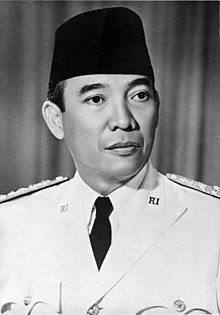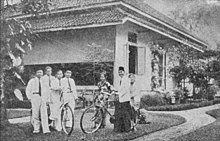HISTORY OF SOEKARNO
Sukarno[a] (/suːˈkɑːrnoʊ/;[2] born Kusno Sosrodihardjo, Javanese: [kʊsnɔ]; 6 June 1901 – 21 June 1970)[3] was the first President of Indonesia, serving from 1945 to 1967.
Sukarno was the leader of his country's struggle for Independence from the Netherlands.
He was a prominent leader of Indonesia's nationalist movement during
the Dutch colonial period, and spent over a decade under Dutch detention
until released by the invading Japanese
forces. Sukarno and his fellow nationalists collaborated to garner
support for the Japanese war effort from the population, in exchange for
Japanese aid in spreading nationalist ideas. Upon Japanese surrender,
Sukarno and Mohammad Hatta
declared Indonesian independence on 17 August 1945, and Sukarno was
appointed as first president.
He led Indonesians in resisting Dutch
re-colonization efforts via diplomatic and military means until the
Dutch acknowledgement of Indonesian independence in 1949. Author
Pramoedya Ananta Toer once wrote "Sukarno was the only Asian leader of
the modern era able to unify people of such differing ethnic, cultural
and religious backgrounds without shedding a drop of blood."[4]
After a chaotic period of parliamentary democracy, Sukarno established an autocratic system called "Guided Democracy"
in 1957 that successfully ended the instability and rebellions which
were threatening the survival of the diverse and fractious country. The
early 1960s saw Sukarno veering Indonesia to the left by providing support and protection to the Indonesian Communist Party (PKI) to the irritation of the military and Islamists. He also embarked on a series of aggressive foreign policies under the rubric of anti-imperialism, with aid from the Soviet Union and China. The failure of the 30 September Movement (1965) led to the destruction of the PKI and his replacement in 1967 by one of his generals, Suharto (see Transition to the New Order), and he remained under house arrest until his death.
Name
The spelling Soekarno, based on Dutch orthography,
is still frequently used, mainly because he signed his name in the old
spelling. Sukarno himself insisted on a "u", not "oe", but said that he
had been told in school to use the Dutch style. He said that it was too
difficult to change his signature, so still wrote it with an "oe".[5] Official Indonesian presidential decrees from the period 1947–1968, however, printed his name using the 1947 spelling. The Soekarno–Hatta International Airport which serves near Jakarta, the capital of Indonesia, still uses the Dutch spelling.
Indonesians also remember him as Bung Karno (Brother/Comrade Karno) or Pak Karno ("Mr. Karno").[6] Like many Javanese people, he had only one name.[7]
According to author Pramoedya Ananta Toer in several interviews, "bung"
is an affectionate title meaning "friend" creatively used to be an
alternative way of addressing person in equal manner, as an opposite
word of old-form "tuan", "mas" or "bang".
He is sometimes referred to in foreign accounts as "Achmad Sukarno",
or some variation thereof. The fictitious first name may have been
added by western journalists confused over someone with just a single
name, or by Indonesian supporters of independence to attract support
from Muslim countries.[7]
Background
The son of a Javanese primary school teacher, an aristocrat named Raden Soekemi Sosrodihardjo, and his Hindu Balinese wife from the Brahmin varna named Ida Ayu Nyoman Rai from Buleleng regency, Sukarno was born at Jalan Pandean IV/40, Soerabaia (now known as Surabaya), East Java, in the Dutch East Indies (now Indonesia).[8][9] He was originally named Kusno Sosrodihardjo.[10] Following Javanese
custom, he was renamed after surviving a childhood illness. After
graduating from a native primary school in 1912, he was sent to the Europeesche Lagere School (a Dutch primary school) in Mojokerto. Subsequently, in 1916, Sukarno went to a Hogere Burgerschool (a Dutch type higher level secondary school) in Surabaya, where he met Tjokroaminoto, a nationalist and founder of Sarekat Islam. In 1920, Sukarno married Tjokroaminoto's daughter Siti Oetari. In 1921, he began to study civil engineering (with focusing on architecture) at the Technische Hoogeschool te Bandoeng (Bandoeng Institute of Technology), where he obtained an Ingenieur degree (abbreviated as "Ir.", a Dutch type engineer's degree) in 1926. During his study in Bandung,
Sukarno became romantically involved with Inggit Garnasih, the wife of
Sanoesi, the owner of the boarding house where he lived as a student.
Inggit was 13 years older than Sukarno. In March 1923, Sukarno divorced
Siti Oetari to marry Inggit (who also divorced her husband Sanoesi).
Sukarno later divorced Inggit and married Fatmawati.
After graduation in 1926, Sukarno and his university friend Anwari established the architectural firm Sukarno & Anwari in Bandung,
which provided planning and contractor services. Among Sukarno's
architectural works are the renovated building of the Preanger Hotel
(1929), where he acted as assistant to famous Dutch architect Charles Prosper Wolff Schoemaker. Sukarno also designed many private houses on today's Jalan Gatot Subroto, Jalan Palasari, and Jalan Dewi Sartika in Bandung. Later on, as president, Sukarno remained engaged in architecture, designing the Proclamation Monument and adjacent Gedung Pola in Jakarta; the Youth Monument (Tugu Muda) in Semarang; the Alun-alun Monument in Malang; the Heroes' Monument in Surabaya; and also the new city of Palangkaraya in Central Kalimantan.
Atypically even among the country's small educated elite, Sukarno was fluent in several languages. In addition to the Javanese language of his childhood, he was a master of Sundanese, Balinese and of Indonesian, and was especially strong in Dutch. He was also quite comfortable in German, English, French, Arabic, and Japanese, all of which were taught at his HBS. He was helped by his photographic memory and precocious mind.[11]
In his studies, Sukarno was "intensely modern," both in architecture and in politics. He despised both the traditional Javanese feudalism, which he considered "backward" and to blame for the fall of the country under Dutch occupation and exploitation, and the imperialism practised by Western countries, which he termed as "exploitation of humans by other humans" (exploitation de l'homme par l'homme).
He blamed this for the deep poverty and low levels of education of
Indonesian people under the Dutch. To promote nationalistic pride
amongst Indonesians, Sukarno interpreted these ideas in his dress, in
his urban planning for the capital (eventually Jakarta), and in his socialist politics, though he did not extend his taste for modern art to pop music; he had Koes Bersaudara
imprisoned for their allegedly decadent lyrics despite his own
reputation for womanising. For Sukarno, modernity was blind to race,
neat and elegant in style, and anti-imperialist.[12]
Independence struggle
Sukarno was first exposed to nationalist ideas while living under Oemar Said Tjokroaminoto. Later, while a student in Bandung,
he immersed himself in European, American, Nationalist, communist, and
religious political philosophy, eventually developing his own political
ideology of Indonesian-style socialist self-sufficiency. He began
styling his ideas as Marhaenism,
named after Marhaen, an Indonesian peasant he met in southern Bandung
area, who owned his little plot of land and worked on it himself,
producing sufficient income to support his family. In university,
Sukarno began organising a study club for Indonesian students, the Algemeene Studieclub, in opposition to the established student clubs dominated by Dutch students.
On 4 July 1927, Sukarno with his friends from the Algemeene Studieclub established a pro-independence party, Partai Nasional Indonesia
(PNI), of which Sukarno was elected the first leader. The party
advocated independence for Indonesia, and opposed imperialism and
capitalism because it opined that both systems worsened the life of
Indonesian people. The party also advocated secularism and unity amongst the many different ethnicities in the Dutch East Indies,
to establish a united Indonesia. Sukarno also hoped that Japan would
commence a war against the western powers and that Java could then gain
its independence with Japan's aid. Coming soon after the disintegration
of Sarekat Islam in the early 1920s and the crushing of Partai Komunis Indonesia
after their failed rebellion of 1926, PNI began to attract a large
number of followers, particularly among the new university-educated
youths eager for larger freedoms and opportunities denied to them in the
racist and constrictive political system of Dutch colonialism.[13]
Sukarno with fellow defendants and attorneys during his trial in Bandung, 1930.
PNI activities came to the attention of the colonial government, and
Sukarno's speeches and meetings were often infiltrated and disrupted by
agents of the colonial secret police (Politieke Inlichtingen Dienst/PID).
Eventually, Sukarno and other key PNI leaders were arrested on 29
December 1929 by Dutch colonial authorities in a series of raids
throughout Java. Sukarno himself was arrested while on a visit to Yogyakarta. During his trial at the Bandung Landraad
courthouse from August to December 1930, Sukarno made a series of long
political speeches attacking colonialism and imperialism, titled Indonesia Menggoegat (Indonesia Accuses).
In December 1930, Sukarno was sentenced to four years in prison,
which were served in Sukamiskin prison in Bandung. His speech, however,
received wide coverage by the press, and due to strong pressure from the
liberal elements in both Netherlands and Dutch East Indies, Sukarno was released early on 31 December 1931. By this time, he had become a popular hero widely known throughout Indonesia.
However, during his imprisonment, PNI had been splintered by
oppression of colonial authorities and internal dissension. The original
PNI was disbanded by the Dutch, and its former members formed two
different parties; the Partai Indonesia (Partindo) under Sukarno's associate Sartono who were promoting mass agitation, and the Pendidikan Nasional Indonesia (PNI Baroe) under Mohammad Hatta and Soetan Sjahrir,
two nationalists who recently returned from studies in the Netherlands,
and who were promoting a long-term strategy of providing modern
education to the uneducated Indonesian populace to develop an
intellectual elite able to offer effective resistance to Dutch rule.
After attempting to reconcile the two parties to establish one united
nationalist front, Sukarno chose to become the head of Partindo on 28
July 1932. Partindo had maintained its alignment with Sukarno's own
strategy of immediate mass agitation, and Sukarno disagreed with Hatta's
long-term cadre-based struggle. Hatta himself believed Indonesian
independence would not occur within his lifetime, while Sukarno believed
Hatta's strategy ignored the fact that politics can only make real
changes through formation and utilisation of force (machtsvorming en machtsaanwending).[13]
During this period, to support himself and the party financially,
Sukarno returned to architecture, opening the bureau of Soekarno &
Rooseno. He also wrote articles for the party's newspaper, Fikiran Ra'jat.
While based in Bandung, Sukarno travelled extensively throughout Java
to establish contacts with other nationalists. His activities attracted
further attention by the Dutch PID. In mid-1933, Sukarno published a
series of writings titled Mentjapai Indonesia Merdeka ("To Attain Independent Indonesia"). For this writing, he was arrested by Dutch police while visiting fellow nationalist Mohammad Hoesni Thamrin in Jakarta on 1 August 1933.
Sukarno at his home in exile, Bengkulu.
This time, to prevent providing Sukarno with a platform to make political speeches, the hardline governor-general Jonkheer Bonifacius Cornelis de Jonge
utilised his emergency powers to send Sukarno to internal exile without
trial. In 1934, Sukarno was shipped, along with his family (including
Inggit Garnasih), to the remote town of Ende, on the island of Flores.
During his time in Flores, he utilised his limited freedom of movement
to establish a children's theatre. Among its members was future
politician Frans Seda. Due to an outbreak of malaria in Flores, the Dutch authorities decided to move Sukarno and his family to Bencoolen (now Bengkulu) on western coast of Sumatra, in February 1938.
In Bengkulu, Sukarno became acquainted with Hassan Din, the local head of Muhammadiyah organisation, and he was allowed to teach religious teachings at a local school owned by the Muhammadiyah. One of his students was 15-year-old Fatmawati,
daughter of Hassan Din. He became romantically involved with Fatmawati,
which he justified by stating the inability of Inggit Garnasih to
produce children during their almost 20-year marriage. Sukarno was still
in Bengkulu exile when the Japanese invaded the archipelago in 1942.




Tidak ada komentar:
Posting Komentar